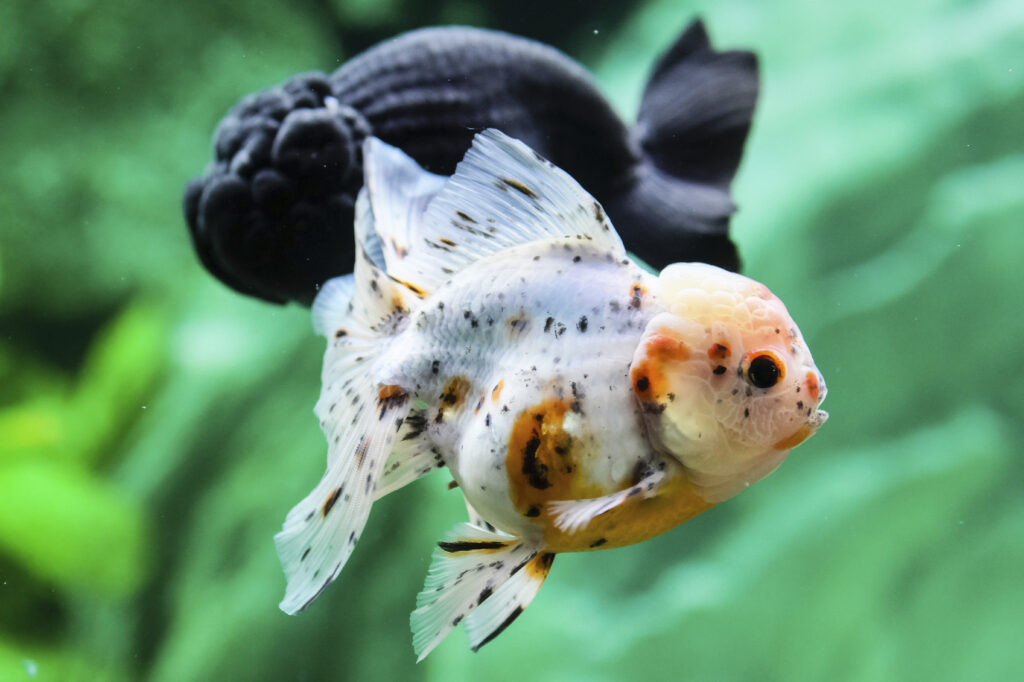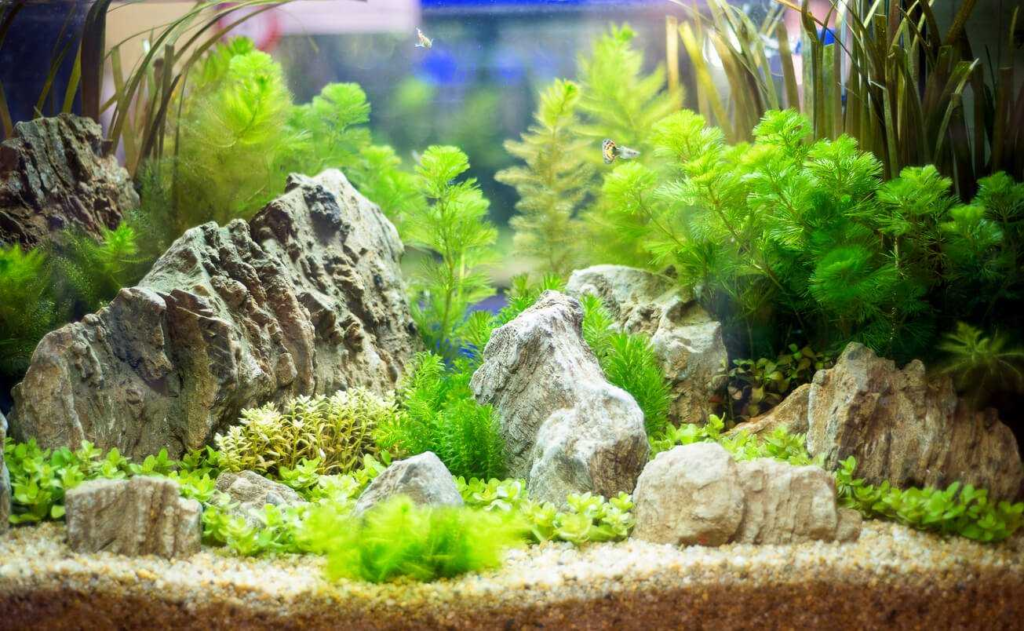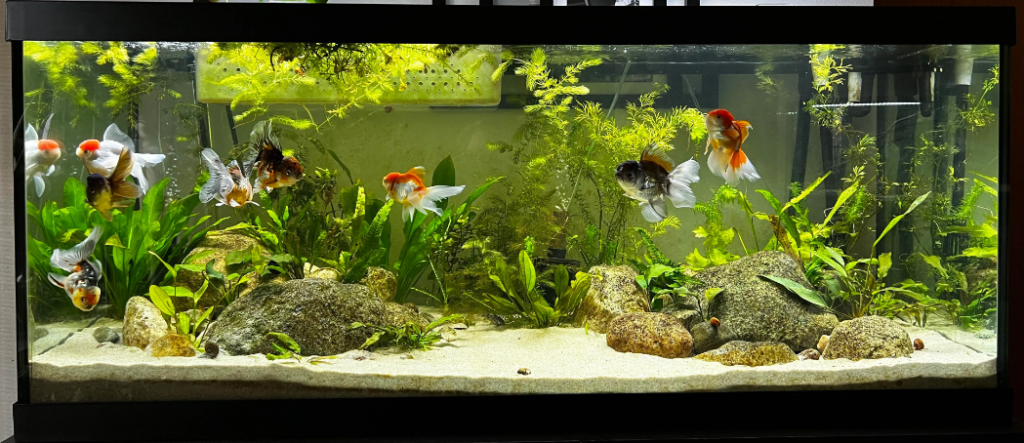
Say hello to your new best friend, ammonia. You know, the smelly, invisible beast that’s quietly lurking in your goldfish tank? That’s right! It’s an unsavory presence that could be turning your pet’s paradise into a toxic soup. Let’s dive in and uncover the horror that ammonia truly is, and how it can turn your goldfish’s life into a floating nightmare.
Here’s the kicker though – plants are the superheroes of this tale. And they are ready to take on the ammonia monster in your tank. Intrigued? You should be! We’ll uncover the world of plants, their ammonia-fighting abilities and how they could be the key to creating the perfect “Goldilocks” environment for your finned friends. Buckle up, it’s going to be a wild, watery ride!
Understanding Ammonia in Aquariums

Ever look at your goldfish tank and wonder what’s brewing in there besides a flipping, finned fiesta? Well, folks, surprise, surprise! It’s ammonia.
The Source of Ammonia in Goldfish Tanks
So, where does this ammonia come from? It’s a mix of Nemo’s dinner leftovers and…wait for it…goldfish poo. Yeah, I know. It’s not the most pleasant thing to think about, but it’s important to know.
Why High Levels of Ammonia are Harmful?
Ammonia isn’t just a stinky inconvenience. It’s akin to your goldfish swimming in its own toilet. If the levels get too high, it can cause damage to their gills, skin, and kidneys. Think of it like trying to breath in a room full of smoke.
Like a breezy transition from a dining room to a living room in an open floor house, we now move from understanding ammonia to how plants can help control it. After all, every superhero needs a villain, and today, our villain is ammonia. Who’s the superhero, you ask? Tune in to the next section!
Role of Plants in Controlling Ammonia

Hold onto your gills lively goldfish parents, it is time to talk about the superhero of our under-water-world. Yes, you guessed it right—the humble aquatic plant! Plants could be the Robin to your Batman, your goldfish’s undersea partner dealing with the nemesis, the harmful ammonia.
Natural Process of Ammonia Absorption by Plants
Plants are smooth operators. They covertly absorb ammonia from the water, using it as a nutrient—a sly action they picked during their evolution adventure. It’s simple, really. As a part of photosynthesis, they absorb nitrites (break down products of ammonia), using them as core substances to create proteins. That’s their secret weapon in this battle against excess ammonia. Is Mother Nature a genius or what? Utilizing a hazard and turning it into something beneficial is quite a cool trick!
Now before we go plant-crazy and transform our goldfish tanks into the Amazon forest, it’s essential to understand which plants do the best job. It’s because not every green dude is suitable for this secretive mission.
Examples of Aquatic Plants That Can Effectively Absorb Ammonia
Let’s dive in and explore some plant options that act as excellent ammonia filters. For fast-growing plants, we have hornwort and duckweed—two top agents in this mission, thanks to their high absorption rate. Moneywort and java moss, although slow growers, pull their weight pretty well too. For the aesthetically conscious, amazon sword and java fern are gorgeous and functional.
In the end, the choice of plant depends on compatibility with your goldfish’s lifestyle and the overall vision you have for the tank. Remember to strike a balance!
In the next section, we’ll dive deeper into the art of curating a goldfish habitat that is not just easy on eyes but also holistically healthy. We are talking about balance—a perfect blend of goldfish and the green gang. Plus, never underestimate the importance of regular old-fashioned water changes, even in this greenery galore. Let’s gear up and dive in!
Creating the Ideal Goldfish Tank Ecosystem

Welcome to a crash course in ecobalance, home-aquarium style! We’re here to make your goldfish tank look less like a watery bachelor pad and more like a lush underwater garden.
Let’s dive right in (hypothetically, of course).
Balancing the Number of Goldfish and Plants
To create The Utterly Perfect Goldfish Haven, you need to strike Goldilocks-like balance between your scaly pals and your leafy greens. Too many fish and not enough plants may mean a spike in ammonia levels. On the other hand, if you put too many plants in anticipation of absorbing more ammonia, you could turn your tank into a claustrophobic underwater jungle. No bueno.
Remember, it’s not a numbers game. It’s more of a balance beam where both sides are equally important. And let’s be honest, walking on a balance beam where one side is full of fish and the other is full of plants sounds way more interesting than regular gymnastics!
Ready for another key point? Of course, you are. Buckle up, buttercup.
Importance of Regular Water Changes Even in Planted Tanks
I know, I know. You’ve got plants in your tank now, working 24/7 to control ammonia and you’re wondering, “Why do I still have to change the water regularly?” Here’s the thing. Plants are great, but they’re not some magical knights, fighting off the ammonia dragon. They have their limits.
While they help a lot, they can’t necessarily keep up with all the ammonia produced, especially if the population of your underwater petting zoo is growing. Regular water changes help maintain the water quality and give a helping hand to your leafy allies.
It’s a little bit like cleaning up the toys after your kids. Just because you bought them a toy-box, doesn’t mean you won’t find a stray Lego under your foot at 3 am.
But hey, maintaining a balanced ecosystem is something worth bragging about to your fellow goldfish enthusiasts. After this lesson in Proactive Goldfish Care 101, you’re all set to prevent a potential ‘Ammogeddon’ in your dream tank! Keep swimming onto the next topic for more golden nuggets of wisdom. Ready to deep dive into some common mistakes people make when trying to control ammonia? Thought so. Let’s dive in!
Common Mistakes When Controlling Ammonia

Let’s shake things up a bit and talk about fishy blunders. Yes, we’re peeping into those fish tank TLC tactics that are going well, ehm…soggy bottom up. Here’s the holy trinity of common mistakes which crank up those pesky ammonia levels.
Overcrowding the Tank
We know, we know. You want to create your own busy underwater Times Square in your aquarium. But, guess what? Overcrowding your tank is like inviting a horde of rowdy frat boys to a tiny studio apartment party, only the hangover is a cloud of ammonia. More fish mean more waste, which translates to more ammonia. That’s simple Fishkeeping 101.
Trimming down the guest list doesn’t necessarily mean that you need to give up on your dream of a vibrant and lively aquarium. A well-sized and appropriate tank can also help manage population density and ensure your fish have the space they need. If you’re considering goldfish, you might want to look at our article on the 10 Best Goldfish Tanks on the Market. These tanks are designed to provide ample room for your aquatic friends, helping to keep those ammonia levels manageable.
So let’s give our finned friends some elbow room, and breathe easy knowing that we’re keeping those ammonia levels on the low.
Overfeeding the Goldfish
Overindulging in a good thing is usually a bad idea. This is just as true for goldfish as it is for us. Every goldfish has an inner Porky Pig that dances a happy jig at the sight of food. It’s a joyous sight, really, making us sometimes a bit too eager to keep the feeding party going. But heed this warning, fellas, overfeeding is a slippery slope.
The issue with overfeeding isn’t just about the fish getting too much food. It’s also about what happens to the uneaten remnants. They decay at the bottom of the tank, and this decomposition welcomes a most unwanted guest – ammonia. High ammonia levels in the tank can cause health problems for your aquatic pet, including gill damage and stress.
Just as we need to exercise control over our late-night snack binges (hello, pizza at midnight) to avoid guilt and keep our pants fitting right, our goldfish require a similar discipline in their diet. It’s crucial to understand not only what to feed them but also how often. For more detailed information on this, you might want to check out this article Goldfish Meals: How Often Should They Be Fed?
So, remember, love for your goldfish isn’t measured in food amounts. The best thing you can do for them is to maintain a healthy, balanced diet that keeps both their bodies and their habitat in top shape.
Neglecting Water Changes in Favour of Plants
Plants are amazing, they’re the unsung heroes of our fishbowls. They’re our goldfish’s underwater cheerleading squad, but hey! Plants alone don’t cut it. They’re not the proverbial magic bullet to swish away all your ammonia troubles.
Don’t just rely on plants and ditch your regular H2O shift. Mix it up with fresh water changes to keep those ammonia levels at bay.
Alright, done with the goof-ups. Up next are the smarty pants solutions to give your goldfish a tankful of joy. Let’s dive in, shall we?
Practical Tips for Reducing Amnesia Levels

Say you just woke up one day and thought, “Hmm, I want my goldfish’s home to be like the Waldorf Astoria for fish!” Well, having such high expectations comes with a bit of work. And, worrying about ammonia levels shouldn’t be your newest insomnia trigger. So, let’s get down to brass tacks and look at some strategies where you exert less and achieve more.
Selecting The Right Plants
First things first, picking the right plants for your goldfish tank is like choosing the right pair of shoes for a marathon. You must get it right! Some plants absorb ammonia much better than others. So which ones are the gold-standards? Plants like hornwort, duckweed, and anacharis are your new best friends. They’re like the superheroes of the plant world, swooping in to save the day, battling and absorbing that pesky ammonia.
For a more detailed exploration of these plant species and how they benefit your goldfish tank, check out our article How to Choose the Right Plants for Your Goldfish? It’s chock-full of additional tips and options that are suitable for your aquatic environment.
If you’re interested in diving even deeper into these plants and finding out more options suitable for your goldfish aquarium, don’t miss our comprehensive guide on the 10 Best Live Plants for a Goldfish Aquarium.
Now, are you ready to make your fish tank the talk of the town – er, room? This is your first step towards creating a vibrant, thriving, and healthy environment for your goldfish.
Ensuring Proper Feeding
Just like you wouldn’t scarf down a whole pizza by yourself (or would you?), try not to overfeed your goldfish. It’s not a food-eating competition! Too much food equals more waste and more waste spells danger in big, bold, ammonia-filled letters.
So, how about we aim to keep the feeding on point, possibly like French dining- small portions, classy, and leaves you wanting more – just not right away.
Maintaining Regular Water Checks
Lastly, don’t play Russian Roulette with water changes. Remember, your plants are the supporting actors, not the lead role in battling ammonia. Weekly checks on that water can help you stay ahead of any hazardous spikes in ammonia levels. Think of it like a weekly check-in on your favorite reality show. Stay tuned for all the latest happenings in your tank!
And that’s a wrap! With the right plants, careful feeding, and regular water checks, your goldfish palace will be a haven free of the traumatic tyranny of ammonia. Tune in next time for more handy hints.
To Sum Up
In the grand scheme of ‘fishy’ things, managing ammonia levels in your dear goldfish’s abode is pivotal. Be aware that it’s a delicate balancing act, playing matchmaker between your goldfish and aquatic plants. Remember, more isn’t always better. Keep a careful check on the population in your watery haven and ensure regular water changes, so your little finned friend isn’t swimming in its waste.
Swim clear of the common traps of overcrowding and overfeeding. These can skyrocket your tank’s ammonia levels to harmful zones. By selecting the right plants, you can create a mini-ecosystem that can absorb this harmful substance. Lastly, join the ‘proper feeder’ club and maintain regular water checks to keep your goldfish healthy and happily flapping to the Wonder-Pets theme song!
Frequently Asked Questions (FAQ)
Question: What is the source of ammonia in goldfish tanks?
Answer: Ammonia primarily comes from the waste products of goldfish. It can also be a result of uneaten food or dead plants decaying in the tank.
Question: Why are high levels of ammonia harmful?
Answer: High levels of ammonia can cause gill damage, stress, illness, and even death in goldfish. It can also disrupt the overall tank ecosystem.
Question: How do plants control ammonia in a goldfish tank?
Answer: Plants act like natural filters. They absorb ammonia during their photosynthesis process, reducing the ammonia level in the water.
Question: What are examples of aquatic plants that can effectively absorb ammonia?
Answer: Examples include Anacharis, Java Fern, and Water Sprite which are excellent ammonia absorbers and good for goldfish tanks.
Question: What are common mistakes when trying to control ammonia?
Answer: Overcrowding the tank, overfeeding the goldfish, and neglecting water changes despite having plants in the tank are common missteps.
Question: How can I effectively reduce ammonia levels in my goldfish tank?
Answer: You can do this by selecting the right plants, ensuring that you don’t overfeed your fish, and conducting regular water checks and changes.



